NURBN2023: Clinical Scenario Report on Heart Failure Case Study
VerifiedAdded on 2022/12/15
|9
|2695
|324
Report
AI Summary
This report presents an analysis of a clinical scenario involving a patient, Deep, who experienced chest pain and was diagnosed with heart failure. The report delves into the rationale behind diagnostic procedures such as ECG and blood tests, explaining their significance in assessing the patient's condition. It explores the pathophysiology of heart failure, detailing its causes, progression, and outcomes, with specific reference to Deep's case. The analysis includes an interpretation of the ECG, identifying the underlying rhythm and other relevant parameters. The report further examines the impact of Deep's medication history, including the use of sildenafil (Viagra) and furosemide, and how these medications interacted to exacerbate his condition. The importance of patient disclosure regarding medication use is emphasized, along with the reasons behind Deep's withholding of information. The report also provides detailed information on the pharmacology of the medications involved, including atenolol and furosemide, discussing their mechanisms of action, side effects, and nursing considerations. Finally, the report investigates the factors contributing to medication non-adherence, specifically focusing on the case of furosemide and the reasons behind the patient's reluctance to take the medication as prescribed.
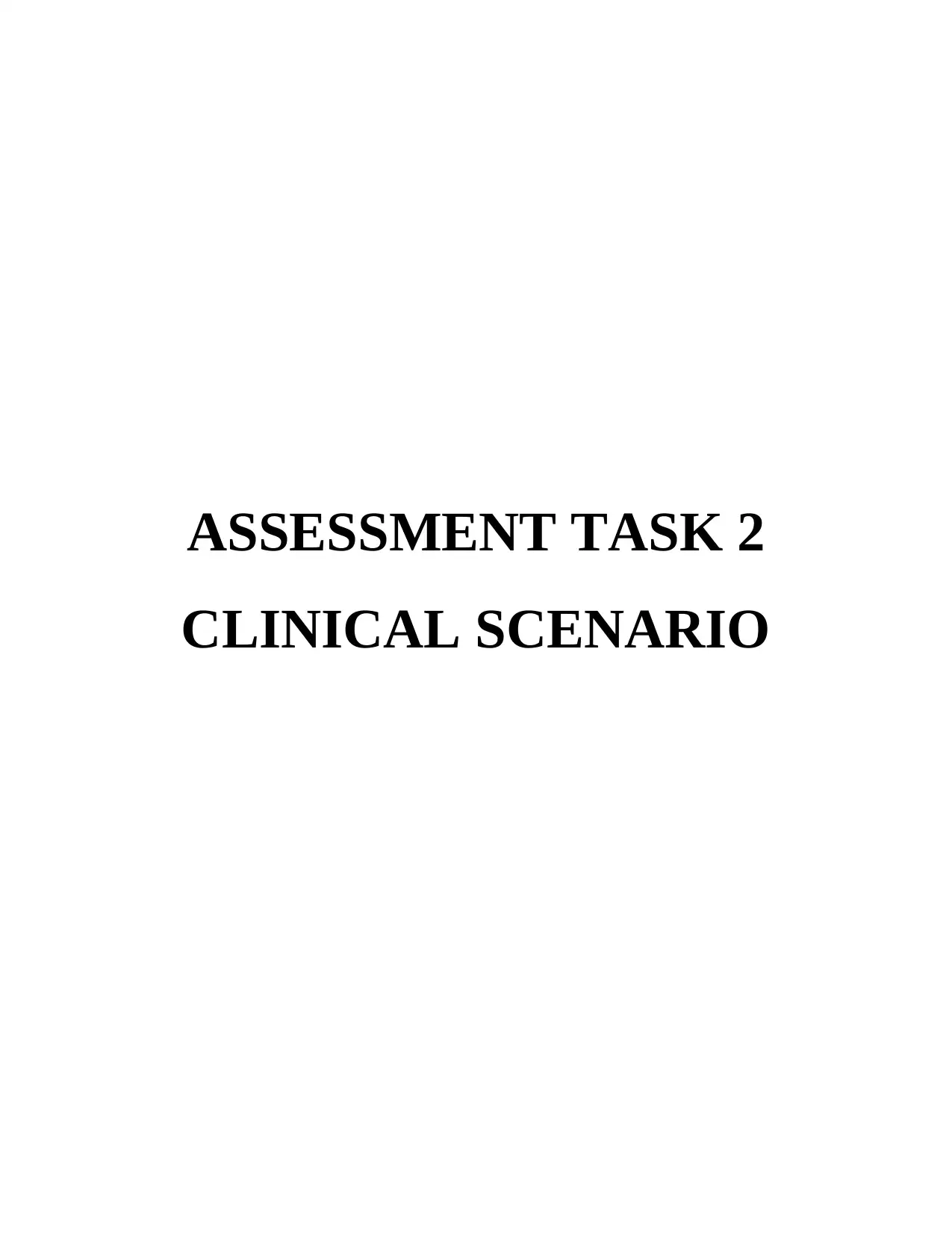
ASSESSMENT TASK 2
CLINICAL SCENARIO
CLINICAL SCENARIO
Paraphrase This Document
Need a fresh take? Get an instant paraphrase of this document with our AI Paraphraser
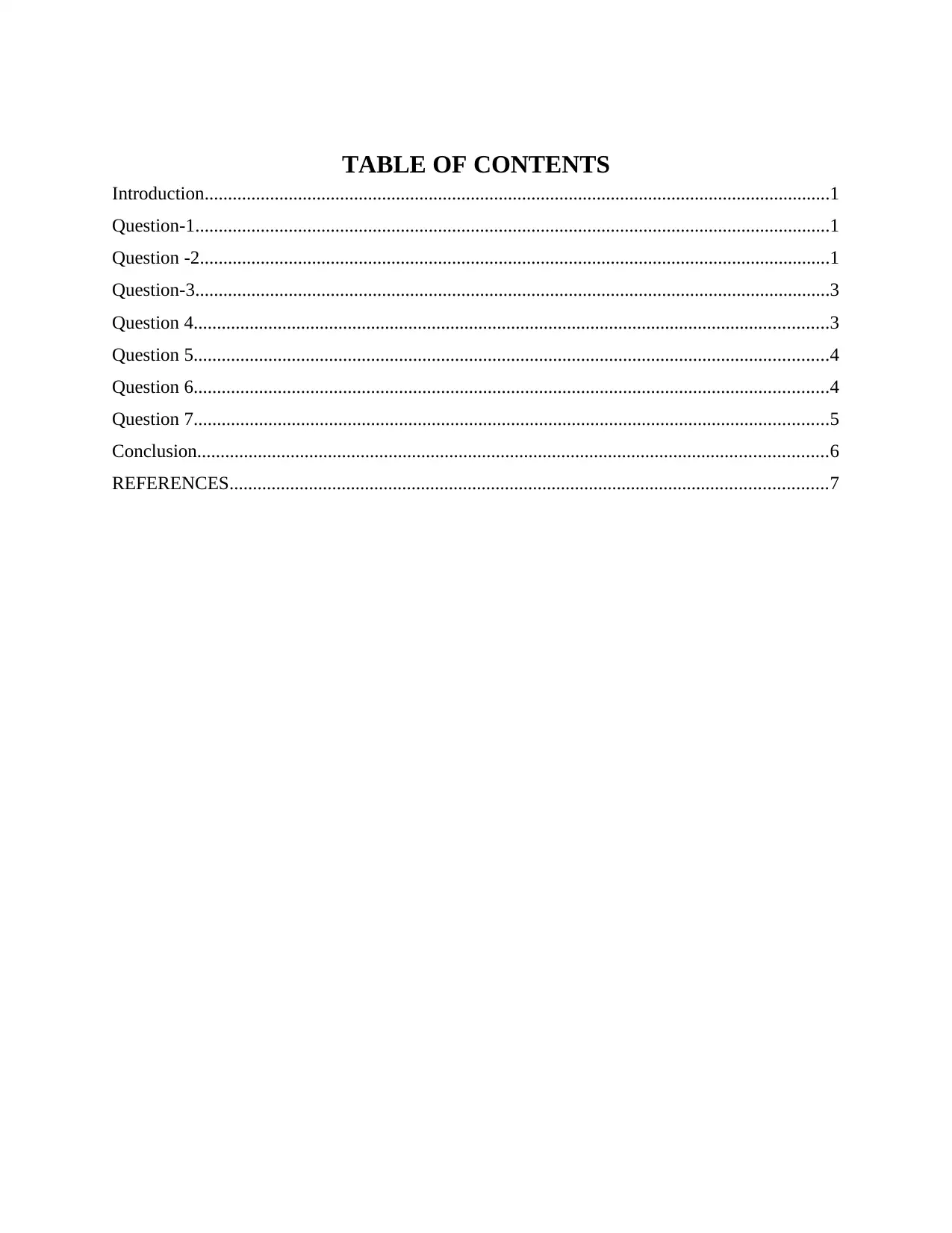
TABLE OF CONTENTS
Introduction......................................................................................................................................1
Question-1........................................................................................................................................1
Question -2.......................................................................................................................................1
Question-3........................................................................................................................................3
Question 4........................................................................................................................................3
Question 5........................................................................................................................................4
Question 6........................................................................................................................................4
Question 7........................................................................................................................................5
Conclusion.......................................................................................................................................6
REFERENCES................................................................................................................................7
Introduction......................................................................................................................................1
Question-1........................................................................................................................................1
Question -2.......................................................................................................................................1
Question-3........................................................................................................................................3
Question 4........................................................................................................................................3
Question 5........................................................................................................................................4
Question 6........................................................................................................................................4
Question 7........................................................................................................................................5
Conclusion.......................................................................................................................................6
REFERENCES................................................................................................................................7
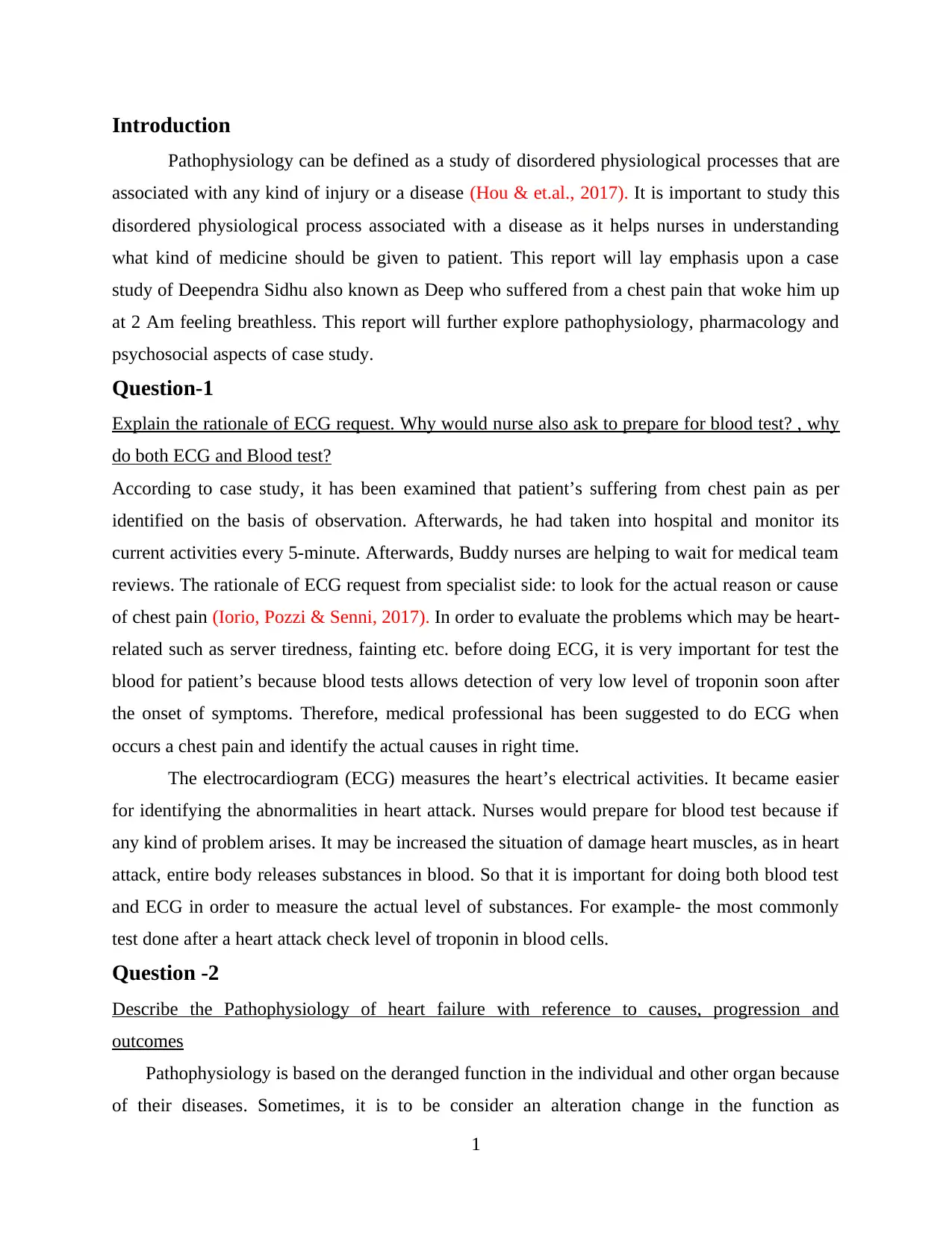
Introduction
Pathophysiology can be defined as a study of disordered physiological processes that are
associated with any kind of injury or a disease (Hou & et.al., 2017). It is important to study this
disordered physiological process associated with a disease as it helps nurses in understanding
what kind of medicine should be given to patient. This report will lay emphasis upon a case
study of Deependra Sidhu also known as Deep who suffered from a chest pain that woke him up
at 2 Am feeling breathless. This report will further explore pathophysiology, pharmacology and
psychosocial aspects of case study.
Question-1
Explain the rationale of ECG request. Why would nurse also ask to prepare for blood test? , why
do both ECG and Blood test?
According to case study, it has been examined that patient’s suffering from chest pain as per
identified on the basis of observation. Afterwards, he had taken into hospital and monitor its
current activities every 5-minute. Afterwards, Buddy nurses are helping to wait for medical team
reviews. The rationale of ECG request from specialist side: to look for the actual reason or cause
of chest pain (Iorio, Pozzi & Senni, 2017). In order to evaluate the problems which may be heart-
related such as server tiredness, fainting etc. before doing ECG, it is very important for test the
blood for patient’s because blood tests allows detection of very low level of troponin soon after
the onset of symptoms. Therefore, medical professional has been suggested to do ECG when
occurs a chest pain and identify the actual causes in right time.
The electrocardiogram (ECG) measures the heart’s electrical activities. It became easier
for identifying the abnormalities in heart attack. Nurses would prepare for blood test because if
any kind of problem arises. It may be increased the situation of damage heart muscles, as in heart
attack, entire body releases substances in blood. So that it is important for doing both blood test
and ECG in order to measure the actual level of substances. For example- the most commonly
test done after a heart attack check level of troponin in blood cells.
Question -2
Describe the Pathophysiology of heart failure with reference to causes, progression and
outcomes
Pathophysiology is based on the deranged function in the individual and other organ because
of their diseases. Sometimes, it is to be consider an alteration change in the function as
1
Pathophysiology can be defined as a study of disordered physiological processes that are
associated with any kind of injury or a disease (Hou & et.al., 2017). It is important to study this
disordered physiological process associated with a disease as it helps nurses in understanding
what kind of medicine should be given to patient. This report will lay emphasis upon a case
study of Deependra Sidhu also known as Deep who suffered from a chest pain that woke him up
at 2 Am feeling breathless. This report will further explore pathophysiology, pharmacology and
psychosocial aspects of case study.
Question-1
Explain the rationale of ECG request. Why would nurse also ask to prepare for blood test? , why
do both ECG and Blood test?
According to case study, it has been examined that patient’s suffering from chest pain as per
identified on the basis of observation. Afterwards, he had taken into hospital and monitor its
current activities every 5-minute. Afterwards, Buddy nurses are helping to wait for medical team
reviews. The rationale of ECG request from specialist side: to look for the actual reason or cause
of chest pain (Iorio, Pozzi & Senni, 2017). In order to evaluate the problems which may be heart-
related such as server tiredness, fainting etc. before doing ECG, it is very important for test the
blood for patient’s because blood tests allows detection of very low level of troponin soon after
the onset of symptoms. Therefore, medical professional has been suggested to do ECG when
occurs a chest pain and identify the actual causes in right time.
The electrocardiogram (ECG) measures the heart’s electrical activities. It became easier
for identifying the abnormalities in heart attack. Nurses would prepare for blood test because if
any kind of problem arises. It may be increased the situation of damage heart muscles, as in heart
attack, entire body releases substances in blood. So that it is important for doing both blood test
and ECG in order to measure the actual level of substances. For example- the most commonly
test done after a heart attack check level of troponin in blood cells.
Question -2
Describe the Pathophysiology of heart failure with reference to causes, progression and
outcomes
Pathophysiology is based on the deranged function in the individual and other organ because
of their diseases. Sometimes, it is to be consider an alteration change in the function as
1
⊘ This is a preview!⊘
Do you want full access?
Subscribe today to unlock all pages.

Trusted by 1+ million students worldwide
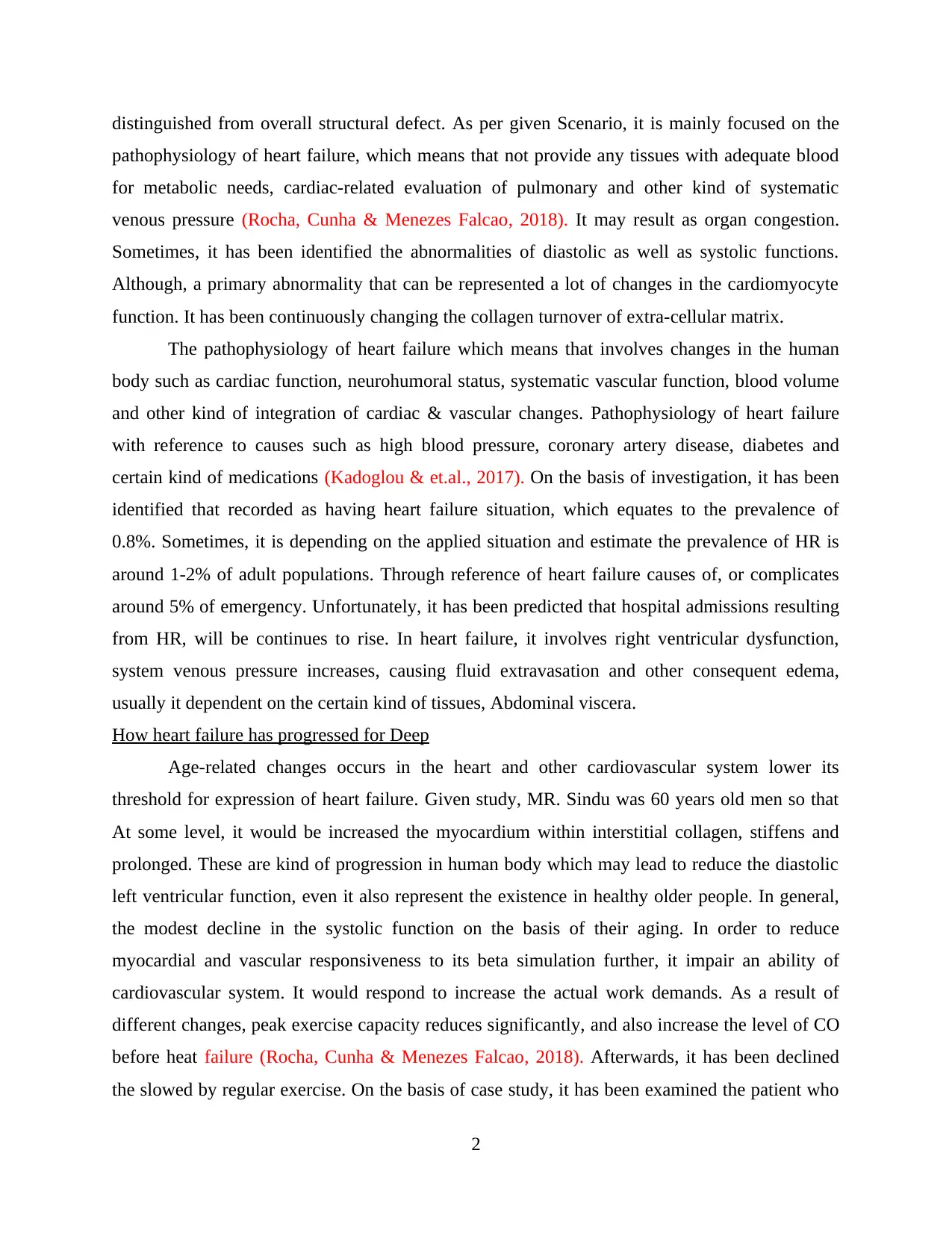
distinguished from overall structural defect. As per given Scenario, it is mainly focused on the
pathophysiology of heart failure, which means that not provide any tissues with adequate blood
for metabolic needs, cardiac-related evaluation of pulmonary and other kind of systematic
venous pressure (Rocha, Cunha & Menezes Falcao, 2018). It may result as organ congestion.
Sometimes, it has been identified the abnormalities of diastolic as well as systolic functions.
Although, a primary abnormality that can be represented a lot of changes in the cardiomyocyte
function. It has been continuously changing the collagen turnover of extra-cellular matrix.
The pathophysiology of heart failure which means that involves changes in the human
body such as cardiac function, neurohumoral status, systematic vascular function, blood volume
and other kind of integration of cardiac & vascular changes. Pathophysiology of heart failure
with reference to causes such as high blood pressure, coronary artery disease, diabetes and
certain kind of medications (Kadoglou & et.al., 2017). On the basis of investigation, it has been
identified that recorded as having heart failure situation, which equates to the prevalence of
0.8%. Sometimes, it is depending on the applied situation and estimate the prevalence of HR is
around 1-2% of adult populations. Through reference of heart failure causes of, or complicates
around 5% of emergency. Unfortunately, it has been predicted that hospital admissions resulting
from HR, will be continues to rise. In heart failure, it involves right ventricular dysfunction,
system venous pressure increases, causing fluid extravasation and other consequent edema,
usually it dependent on the certain kind of tissues, Abdominal viscera.
How heart failure has progressed for Deep
Age-related changes occurs in the heart and other cardiovascular system lower its
threshold for expression of heart failure. Given study, MR. Sindu was 60 years old men so that
At some level, it would be increased the myocardium within interstitial collagen, stiffens and
prolonged. These are kind of progression in human body which may lead to reduce the diastolic
left ventricular function, even it also represent the existence in healthy older people. In general,
the modest decline in the systolic function on the basis of their aging. In order to reduce
myocardial and vascular responsiveness to its beta simulation further, it impair an ability of
cardiovascular system. It would respond to increase the actual work demands. As a result of
different changes, peak exercise capacity reduces significantly, and also increase the level of CO
before heat failure (Rocha, Cunha & Menezes Falcao, 2018). Afterwards, it has been declined
the slowed by regular exercise. On the basis of case study, it has been examined the patient who
2
pathophysiology of heart failure, which means that not provide any tissues with adequate blood
for metabolic needs, cardiac-related evaluation of pulmonary and other kind of systematic
venous pressure (Rocha, Cunha & Menezes Falcao, 2018). It may result as organ congestion.
Sometimes, it has been identified the abnormalities of diastolic as well as systolic functions.
Although, a primary abnormality that can be represented a lot of changes in the cardiomyocyte
function. It has been continuously changing the collagen turnover of extra-cellular matrix.
The pathophysiology of heart failure which means that involves changes in the human
body such as cardiac function, neurohumoral status, systematic vascular function, blood volume
and other kind of integration of cardiac & vascular changes. Pathophysiology of heart failure
with reference to causes such as high blood pressure, coronary artery disease, diabetes and
certain kind of medications (Kadoglou & et.al., 2017). On the basis of investigation, it has been
identified that recorded as having heart failure situation, which equates to the prevalence of
0.8%. Sometimes, it is depending on the applied situation and estimate the prevalence of HR is
around 1-2% of adult populations. Through reference of heart failure causes of, or complicates
around 5% of emergency. Unfortunately, it has been predicted that hospital admissions resulting
from HR, will be continues to rise. In heart failure, it involves right ventricular dysfunction,
system venous pressure increases, causing fluid extravasation and other consequent edema,
usually it dependent on the certain kind of tissues, Abdominal viscera.
How heart failure has progressed for Deep
Age-related changes occurs in the heart and other cardiovascular system lower its
threshold for expression of heart failure. Given study, MR. Sindu was 60 years old men so that
At some level, it would be increased the myocardium within interstitial collagen, stiffens and
prolonged. These are kind of progression in human body which may lead to reduce the diastolic
left ventricular function, even it also represent the existence in healthy older people. In general,
the modest decline in the systolic function on the basis of their aging. In order to reduce
myocardial and vascular responsiveness to its beta simulation further, it impair an ability of
cardiovascular system. It would respond to increase the actual work demands. As a result of
different changes, peak exercise capacity reduces significantly, and also increase the level of CO
before heat failure (Rocha, Cunha & Menezes Falcao, 2018). Afterwards, it has been declined
the slowed by regular exercise. On the basis of case study, it has been examined the patient who
2
Paraphrase This Document
Need a fresh take? Get an instant paraphrase of this document with our AI Paraphraser
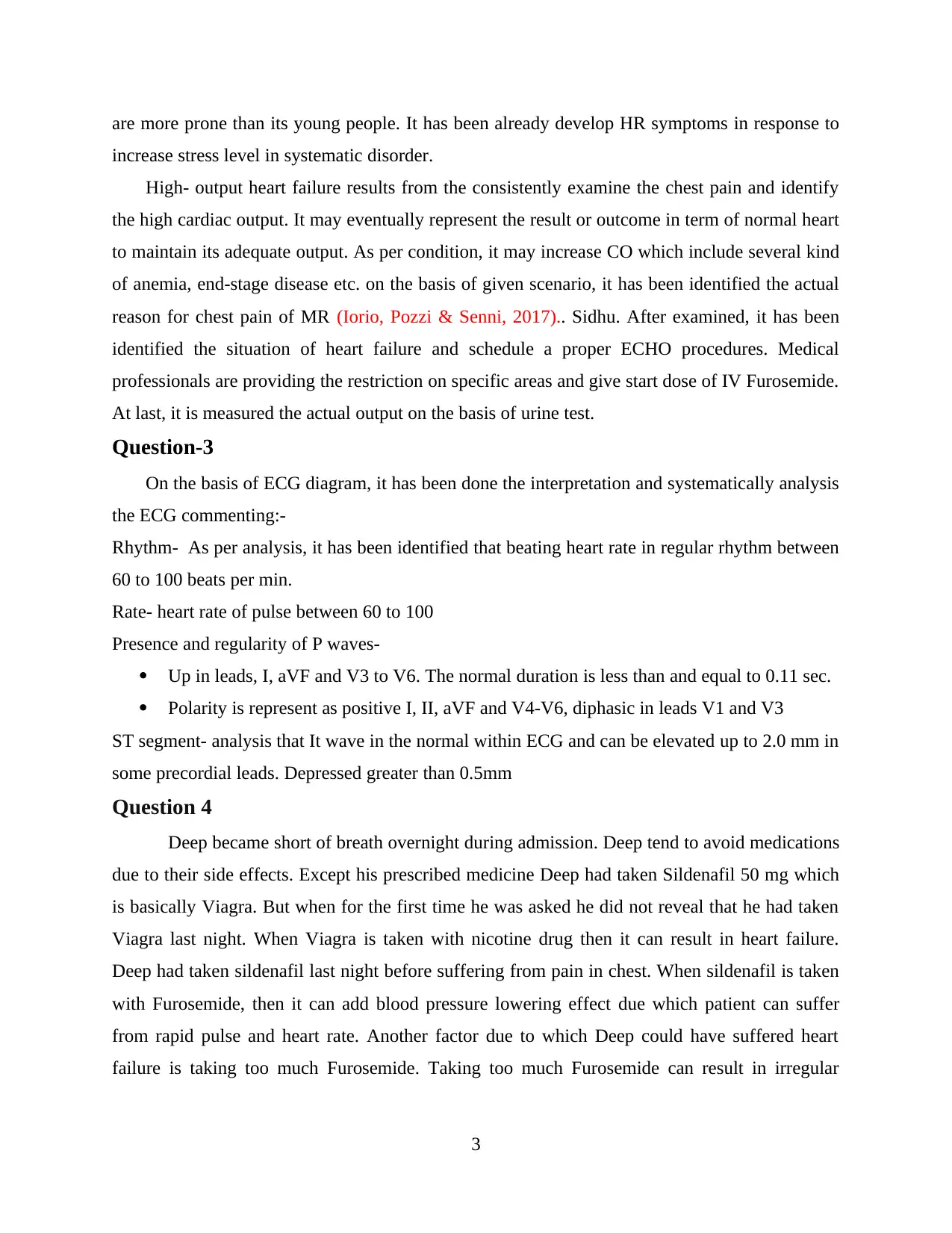
are more prone than its young people. It has been already develop HR symptoms in response to
increase stress level in systematic disorder.
High- output heart failure results from the consistently examine the chest pain and identify
the high cardiac output. It may eventually represent the result or outcome in term of normal heart
to maintain its adequate output. As per condition, it may increase CO which include several kind
of anemia, end-stage disease etc. on the basis of given scenario, it has been identified the actual
reason for chest pain of MR (Iorio, Pozzi & Senni, 2017).. Sidhu. After examined, it has been
identified the situation of heart failure and schedule a proper ECHO procedures. Medical
professionals are providing the restriction on specific areas and give start dose of IV Furosemide.
At last, it is measured the actual output on the basis of urine test.
Question-3
On the basis of ECG diagram, it has been done the interpretation and systematically analysis
the ECG commenting:-
Rhythm- As per analysis, it has been identified that beating heart rate in regular rhythm between
60 to 100 beats per min.
Rate- heart rate of pulse between 60 to 100
Presence and regularity of P waves-
Up in leads, I, aVF and V3 to V6. The normal duration is less than and equal to 0.11 sec.
Polarity is represent as positive I, II, aVF and V4-V6, diphasic in leads V1 and V3
ST segment- analysis that It wave in the normal within ECG and can be elevated up to 2.0 mm in
some precordial leads. Depressed greater than 0.5mm
Question 4
Deep became short of breath overnight during admission. Deep tend to avoid medications
due to their side effects. Except his prescribed medicine Deep had taken Sildenafil 50 mg which
is basically Viagra. But when for the first time he was asked he did not reveal that he had taken
Viagra last night. When Viagra is taken with nicotine drug then it can result in heart failure.
Deep had taken sildenafil last night before suffering from pain in chest. When sildenafil is taken
with Furosemide, then it can add blood pressure lowering effect due which patient can suffer
from rapid pulse and heart rate. Another factor due to which Deep could have suffered heart
failure is taking too much Furosemide. Taking too much Furosemide can result in irregular
3
increase stress level in systematic disorder.
High- output heart failure results from the consistently examine the chest pain and identify
the high cardiac output. It may eventually represent the result or outcome in term of normal heart
to maintain its adequate output. As per condition, it may increase CO which include several kind
of anemia, end-stage disease etc. on the basis of given scenario, it has been identified the actual
reason for chest pain of MR (Iorio, Pozzi & Senni, 2017).. Sidhu. After examined, it has been
identified the situation of heart failure and schedule a proper ECHO procedures. Medical
professionals are providing the restriction on specific areas and give start dose of IV Furosemide.
At last, it is measured the actual output on the basis of urine test.
Question-3
On the basis of ECG diagram, it has been done the interpretation and systematically analysis
the ECG commenting:-
Rhythm- As per analysis, it has been identified that beating heart rate in regular rhythm between
60 to 100 beats per min.
Rate- heart rate of pulse between 60 to 100
Presence and regularity of P waves-
Up in leads, I, aVF and V3 to V6. The normal duration is less than and equal to 0.11 sec.
Polarity is represent as positive I, II, aVF and V4-V6, diphasic in leads V1 and V3
ST segment- analysis that It wave in the normal within ECG and can be elevated up to 2.0 mm in
some precordial leads. Depressed greater than 0.5mm
Question 4
Deep became short of breath overnight during admission. Deep tend to avoid medications
due to their side effects. Except his prescribed medicine Deep had taken Sildenafil 50 mg which
is basically Viagra. But when for the first time he was asked he did not reveal that he had taken
Viagra last night. When Viagra is taken with nicotine drug then it can result in heart failure.
Deep had taken sildenafil last night before suffering from pain in chest. When sildenafil is taken
with Furosemide, then it can add blood pressure lowering effect due which patient can suffer
from rapid pulse and heart rate. Another factor due to which Deep could have suffered heart
failure is taking too much Furosemide. Taking too much Furosemide can result in irregular
3
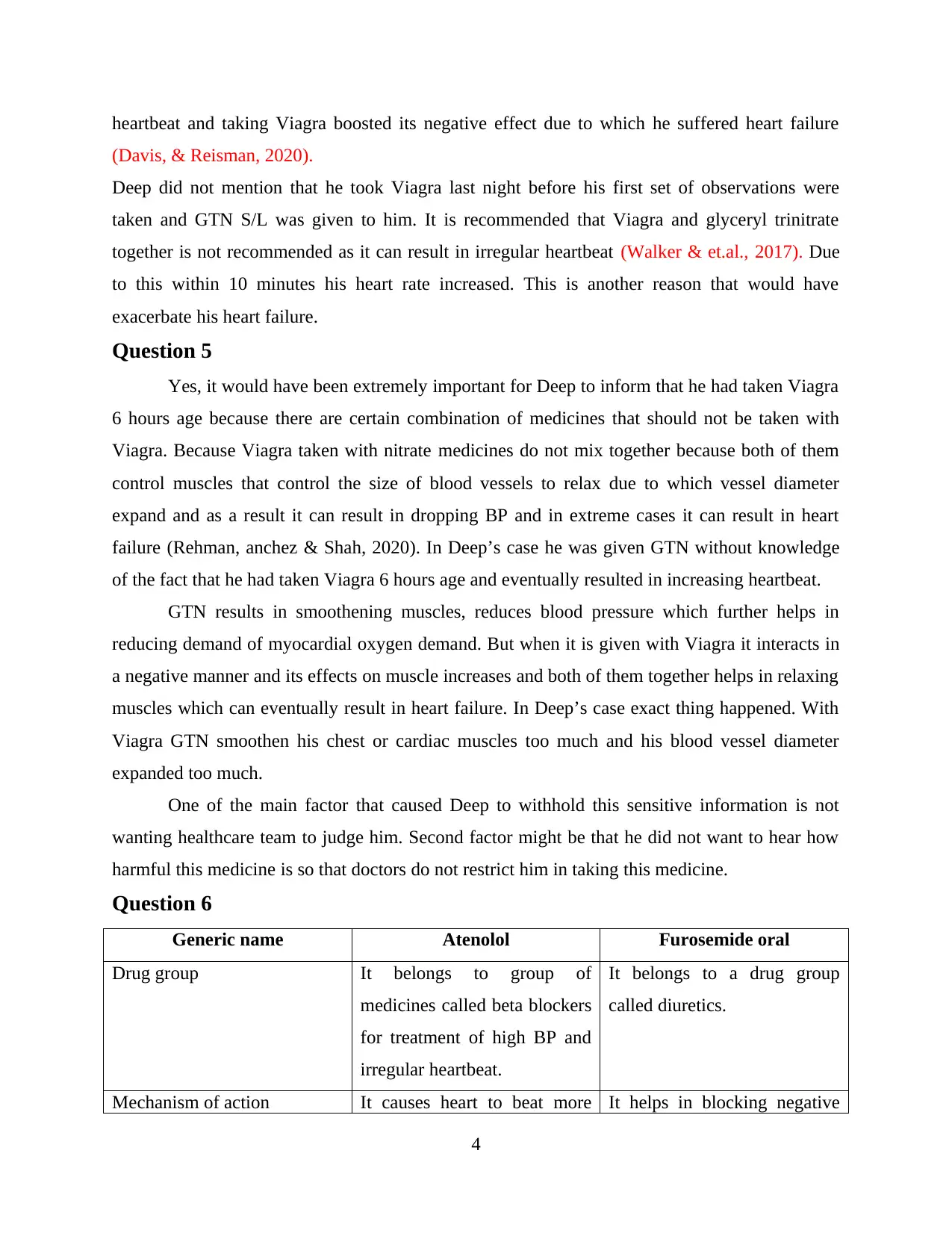
heartbeat and taking Viagra boosted its negative effect due to which he suffered heart failure
(Davis, & Reisman, 2020).
Deep did not mention that he took Viagra last night before his first set of observations were
taken and GTN S/L was given to him. It is recommended that Viagra and glyceryl trinitrate
together is not recommended as it can result in irregular heartbeat (Walker & et.al., 2017). Due
to this within 10 minutes his heart rate increased. This is another reason that would have
exacerbate his heart failure.
Question 5
Yes, it would have been extremely important for Deep to inform that he had taken Viagra
6 hours age because there are certain combination of medicines that should not be taken with
Viagra. Because Viagra taken with nitrate medicines do not mix together because both of them
control muscles that control the size of blood vessels to relax due to which vessel diameter
expand and as a result it can result in dropping BP and in extreme cases it can result in heart
failure (Rehman, anchez & Shah, 2020). In Deep’s case he was given GTN without knowledge
of the fact that he had taken Viagra 6 hours age and eventually resulted in increasing heartbeat.
GTN results in smoothening muscles, reduces blood pressure which further helps in
reducing demand of myocardial oxygen demand. But when it is given with Viagra it interacts in
a negative manner and its effects on muscle increases and both of them together helps in relaxing
muscles which can eventually result in heart failure. In Deep’s case exact thing happened. With
Viagra GTN smoothen his chest or cardiac muscles too much and his blood vessel diameter
expanded too much.
One of the main factor that caused Deep to withhold this sensitive information is not
wanting healthcare team to judge him. Second factor might be that he did not want to hear how
harmful this medicine is so that doctors do not restrict him in taking this medicine.
Question 6
Generic name Atenolol Furosemide oral
Drug group It belongs to group of
medicines called beta blockers
for treatment of high BP and
irregular heartbeat.
It belongs to a drug group
called diuretics.
Mechanism of action It causes heart to beat more It helps in blocking negative
4
(Davis, & Reisman, 2020).
Deep did not mention that he took Viagra last night before his first set of observations were
taken and GTN S/L was given to him. It is recommended that Viagra and glyceryl trinitrate
together is not recommended as it can result in irregular heartbeat (Walker & et.al., 2017). Due
to this within 10 minutes his heart rate increased. This is another reason that would have
exacerbate his heart failure.
Question 5
Yes, it would have been extremely important for Deep to inform that he had taken Viagra
6 hours age because there are certain combination of medicines that should not be taken with
Viagra. Because Viagra taken with nitrate medicines do not mix together because both of them
control muscles that control the size of blood vessels to relax due to which vessel diameter
expand and as a result it can result in dropping BP and in extreme cases it can result in heart
failure (Rehman, anchez & Shah, 2020). In Deep’s case he was given GTN without knowledge
of the fact that he had taken Viagra 6 hours age and eventually resulted in increasing heartbeat.
GTN results in smoothening muscles, reduces blood pressure which further helps in
reducing demand of myocardial oxygen demand. But when it is given with Viagra it interacts in
a negative manner and its effects on muscle increases and both of them together helps in relaxing
muscles which can eventually result in heart failure. In Deep’s case exact thing happened. With
Viagra GTN smoothen his chest or cardiac muscles too much and his blood vessel diameter
expanded too much.
One of the main factor that caused Deep to withhold this sensitive information is not
wanting healthcare team to judge him. Second factor might be that he did not want to hear how
harmful this medicine is so that doctors do not restrict him in taking this medicine.
Question 6
Generic name Atenolol Furosemide oral
Drug group It belongs to group of
medicines called beta blockers
for treatment of high BP and
irregular heartbeat.
It belongs to a drug group
called diuretics.
Mechanism of action It causes heart to beat more It helps in blocking negative
4
⊘ This is a preview!⊘
Do you want full access?
Subscribe today to unlock all pages.

Trusted by 1+ million students worldwide
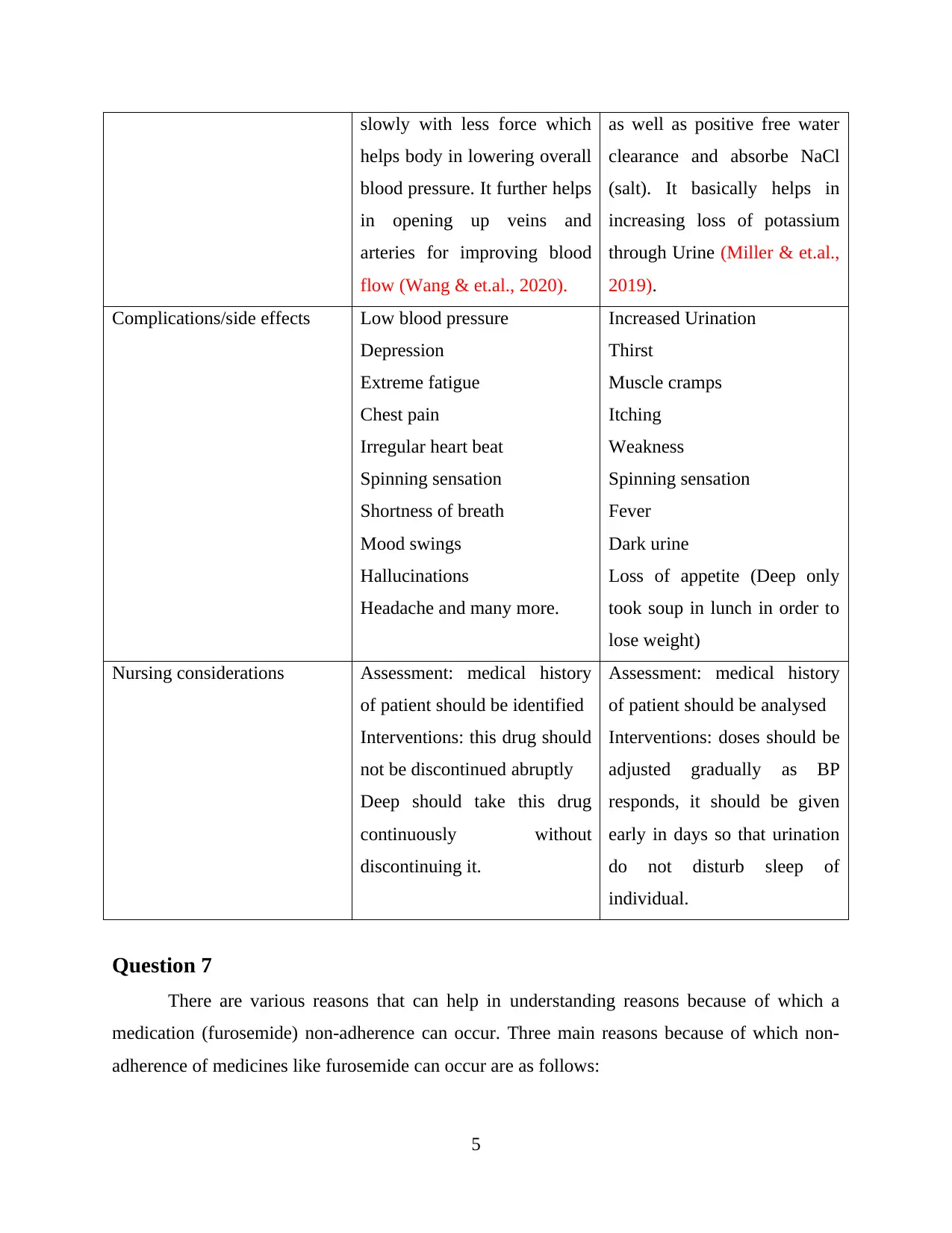
slowly with less force which
helps body in lowering overall
blood pressure. It further helps
in opening up veins and
arteries for improving blood
flow (Wang & et.al., 2020).
as well as positive free water
clearance and absorbe NaCl
(salt). It basically helps in
increasing loss of potassium
through Urine (Miller & et.al.,
2019).
Complications/side effects Low blood pressure
Depression
Extreme fatigue
Chest pain
Irregular heart beat
Spinning sensation
Shortness of breath
Mood swings
Hallucinations
Headache and many more.
Increased Urination
Thirst
Muscle cramps
Itching
Weakness
Spinning sensation
Fever
Dark urine
Loss of appetite (Deep only
took soup in lunch in order to
lose weight)
Nursing considerations Assessment: medical history
of patient should be identified
Interventions: this drug should
not be discontinued abruptly
Deep should take this drug
continuously without
discontinuing it.
Assessment: medical history
of patient should be analysed
Interventions: doses should be
adjusted gradually as BP
responds, it should be given
early in days so that urination
do not disturb sleep of
individual.
Question 7
There are various reasons that can help in understanding reasons because of which a
medication (furosemide) non-adherence can occur. Three main reasons because of which non-
adherence of medicines like furosemide can occur are as follows:
5
helps body in lowering overall
blood pressure. It further helps
in opening up veins and
arteries for improving blood
flow (Wang & et.al., 2020).
as well as positive free water
clearance and absorbe NaCl
(salt). It basically helps in
increasing loss of potassium
through Urine (Miller & et.al.,
2019).
Complications/side effects Low blood pressure
Depression
Extreme fatigue
Chest pain
Irregular heart beat
Spinning sensation
Shortness of breath
Mood swings
Hallucinations
Headache and many more.
Increased Urination
Thirst
Muscle cramps
Itching
Weakness
Spinning sensation
Fever
Dark urine
Loss of appetite (Deep only
took soup in lunch in order to
lose weight)
Nursing considerations Assessment: medical history
of patient should be identified
Interventions: this drug should
not be discontinued abruptly
Deep should take this drug
continuously without
discontinuing it.
Assessment: medical history
of patient should be analysed
Interventions: doses should be
adjusted gradually as BP
responds, it should be given
early in days so that urination
do not disturb sleep of
individual.
Question 7
There are various reasons that can help in understanding reasons because of which a
medication (furosemide) non-adherence can occur. Three main reasons because of which non-
adherence of medicines like furosemide can occur are as follows:
5
Paraphrase This Document
Need a fresh take? Get an instant paraphrase of this document with our AI Paraphraser
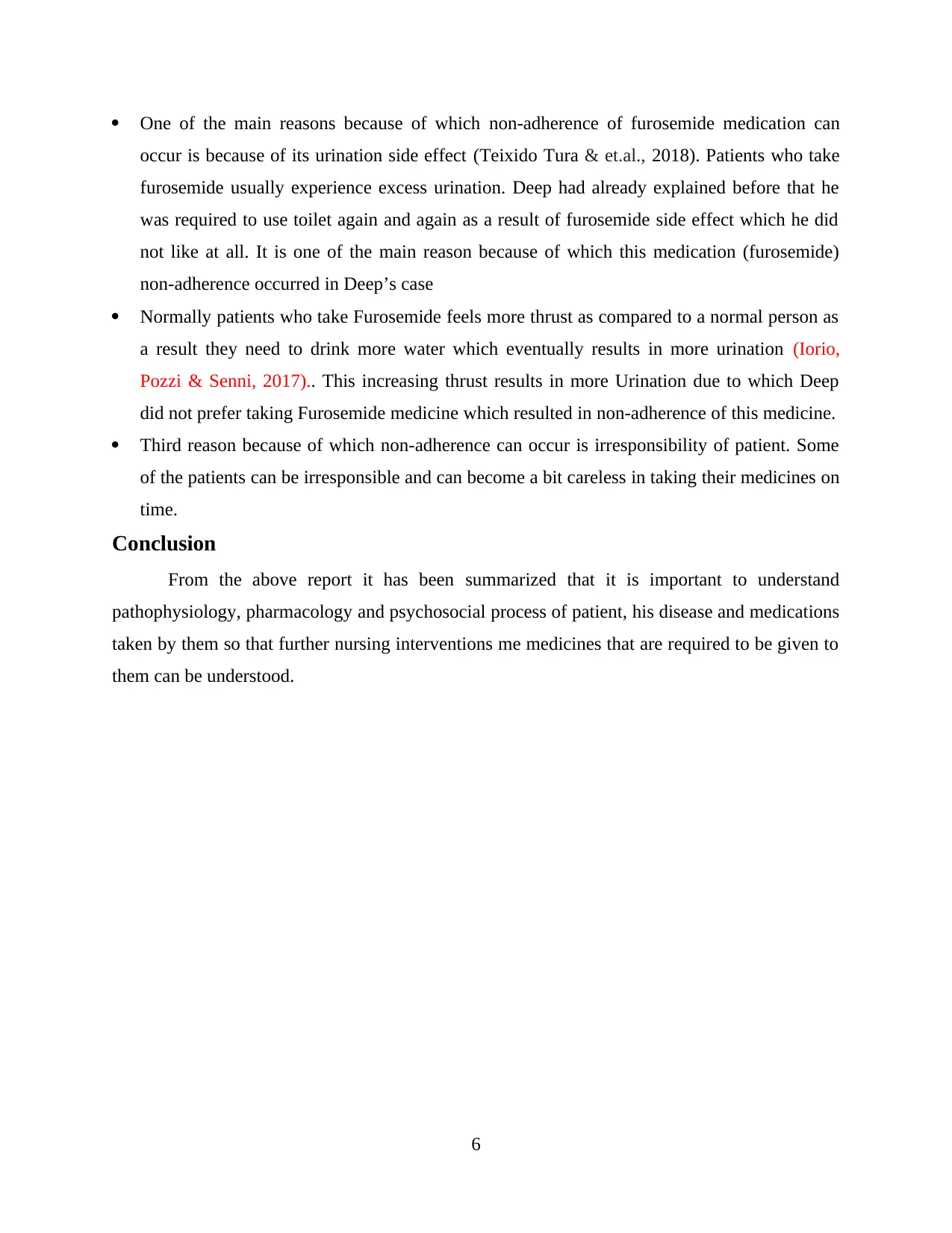
One of the main reasons because of which non-adherence of furosemide medication can
occur is because of its urination side effect (Teixido Tura & et.al., 2018). Patients who take
furosemide usually experience excess urination. Deep had already explained before that he
was required to use toilet again and again as a result of furosemide side effect which he did
not like at all. It is one of the main reason because of which this medication (furosemide)
non-adherence occurred in Deep’s case
Normally patients who take Furosemide feels more thrust as compared to a normal person as
a result they need to drink more water which eventually results in more urination (Iorio,
Pozzi & Senni, 2017).. This increasing thrust results in more Urination due to which Deep
did not prefer taking Furosemide medicine which resulted in non-adherence of this medicine.
Third reason because of which non-adherence can occur is irresponsibility of patient. Some
of the patients can be irresponsible and can become a bit careless in taking their medicines on
time.
Conclusion
From the above report it has been summarized that it is important to understand
pathophysiology, pharmacology and psychosocial process of patient, his disease and medications
taken by them so that further nursing interventions me medicines that are required to be given to
them can be understood.
6
occur is because of its urination side effect (Teixido Tura & et.al., 2018). Patients who take
furosemide usually experience excess urination. Deep had already explained before that he
was required to use toilet again and again as a result of furosemide side effect which he did
not like at all. It is one of the main reason because of which this medication (furosemide)
non-adherence occurred in Deep’s case
Normally patients who take Furosemide feels more thrust as compared to a normal person as
a result they need to drink more water which eventually results in more urination (Iorio,
Pozzi & Senni, 2017).. This increasing thrust results in more Urination due to which Deep
did not prefer taking Furosemide medicine which resulted in non-adherence of this medicine.
Third reason because of which non-adherence can occur is irresponsibility of patient. Some
of the patients can be irresponsible and can become a bit careless in taking their medicines on
time.
Conclusion
From the above report it has been summarized that it is important to understand
pathophysiology, pharmacology and psychosocial process of patient, his disease and medications
taken by them so that further nursing interventions me medicines that are required to be given to
them can be understood.
6
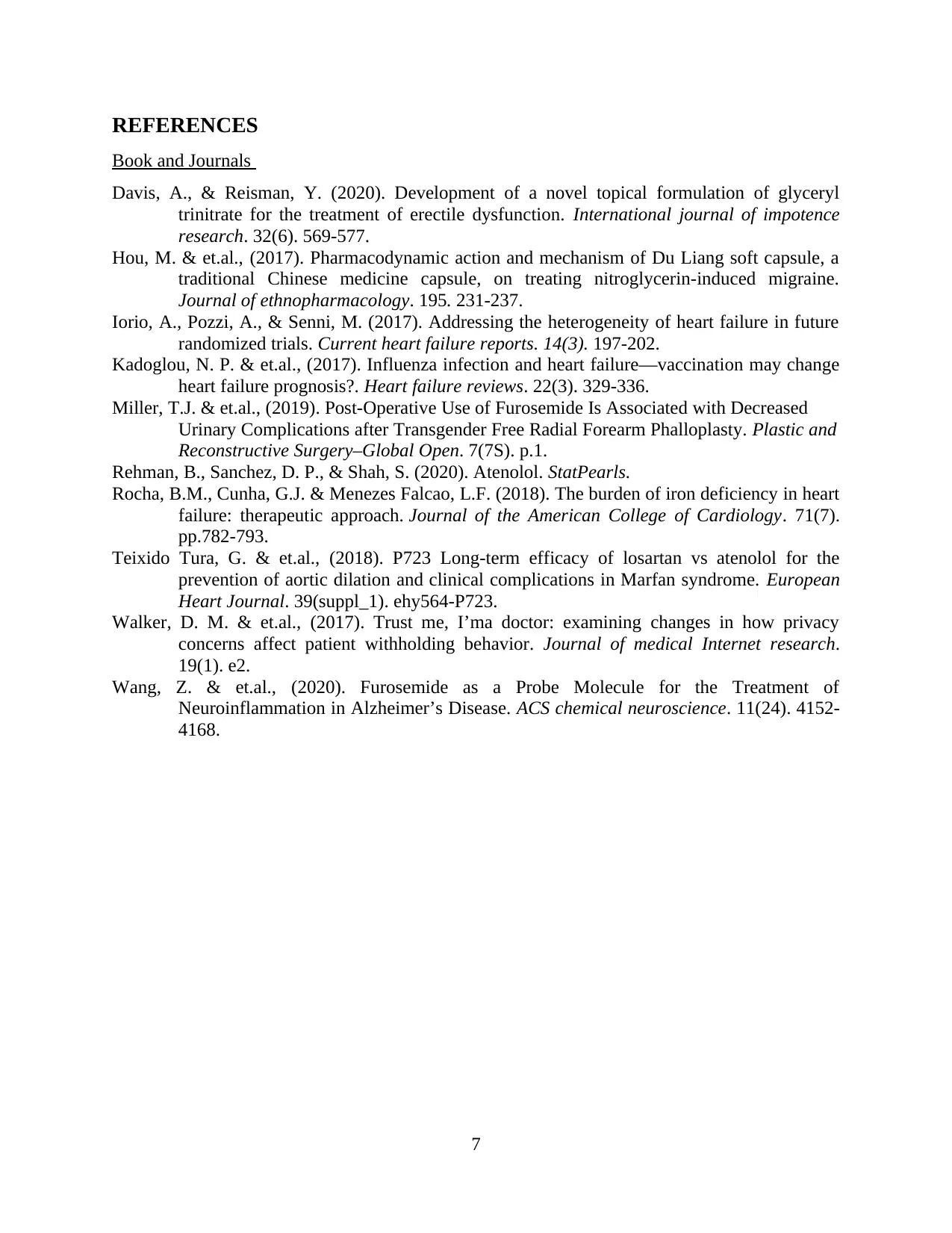
REFERENCES
Book and Journals
Davis, A., & Reisman, Y. (2020). Development of a novel topical formulation of glyceryl
trinitrate for the treatment of erectile dysfunction. International journal of impotence
research. 32(6). 569-577.
Hou, M. & et.al., (2017). Pharmacodynamic action and mechanism of Du Liang soft capsule, a
traditional Chinese medicine capsule, on treating nitroglycerin-induced migraine.
Journal of ethnopharmacology. 195. 231-237.
Iorio, A., Pozzi, A., & Senni, M. (2017). Addressing the heterogeneity of heart failure in future
randomized trials. Current heart failure reports. 14(3). 197-202.
Kadoglou, N. P. & et.al., (2017). Influenza infection and heart failure—vaccination may change
heart failure prognosis?. Heart failure reviews. 22(3). 329-336.
Miller, T.J. & et.al., (2019). Post-Operative Use of Furosemide Is Associated with Decreased
Urinary Complications after Transgender Free Radial Forearm Phalloplasty. Plastic and
Reconstructive Surgery–Global Open. 7(7S). p.1.
Rehman, B., Sanchez, D. P., & Shah, S. (2020). Atenolol. StatPearls.
Rocha, B.M., Cunha, G.J. & Menezes Falcao, L.F. (2018). The burden of iron deficiency in heart
failure: therapeutic approach. Journal of the American College of Cardiology. 71(7).
pp.782-793.
Teixido Tura, G. & et.al., (2018). P723 Long-term efficacy of losartan vs atenolol for the
prevention of aortic dilation and clinical complications in Marfan syndrome. European
Heart Journal. 39(suppl_1). ehy564-P723.
Walker, D. M. & et.al., (2017). Trust me, I’ma doctor: examining changes in how privacy
concerns affect patient withholding behavior. Journal of medical Internet research.
19(1). e2.
Wang, Z. & et.al., (2020). Furosemide as a Probe Molecule for the Treatment of
Neuroinflammation in Alzheimer’s Disease. ACS chemical neuroscience. 11(24). 4152-
4168.
7
Book and Journals
Davis, A., & Reisman, Y. (2020). Development of a novel topical formulation of glyceryl
trinitrate for the treatment of erectile dysfunction. International journal of impotence
research. 32(6). 569-577.
Hou, M. & et.al., (2017). Pharmacodynamic action and mechanism of Du Liang soft capsule, a
traditional Chinese medicine capsule, on treating nitroglycerin-induced migraine.
Journal of ethnopharmacology. 195. 231-237.
Iorio, A., Pozzi, A., & Senni, M. (2017). Addressing the heterogeneity of heart failure in future
randomized trials. Current heart failure reports. 14(3). 197-202.
Kadoglou, N. P. & et.al., (2017). Influenza infection and heart failure—vaccination may change
heart failure prognosis?. Heart failure reviews. 22(3). 329-336.
Miller, T.J. & et.al., (2019). Post-Operative Use of Furosemide Is Associated with Decreased
Urinary Complications after Transgender Free Radial Forearm Phalloplasty. Plastic and
Reconstructive Surgery–Global Open. 7(7S). p.1.
Rehman, B., Sanchez, D. P., & Shah, S. (2020). Atenolol. StatPearls.
Rocha, B.M., Cunha, G.J. & Menezes Falcao, L.F. (2018). The burden of iron deficiency in heart
failure: therapeutic approach. Journal of the American College of Cardiology. 71(7).
pp.782-793.
Teixido Tura, G. & et.al., (2018). P723 Long-term efficacy of losartan vs atenolol for the
prevention of aortic dilation and clinical complications in Marfan syndrome. European
Heart Journal. 39(suppl_1). ehy564-P723.
Walker, D. M. & et.al., (2017). Trust me, I’ma doctor: examining changes in how privacy
concerns affect patient withholding behavior. Journal of medical Internet research.
19(1). e2.
Wang, Z. & et.al., (2020). Furosemide as a Probe Molecule for the Treatment of
Neuroinflammation in Alzheimer’s Disease. ACS chemical neuroscience. 11(24). 4152-
4168.
7
⊘ This is a preview!⊘
Do you want full access?
Subscribe today to unlock all pages.

Trusted by 1+ million students worldwide
1 out of 9
Related Documents
Your All-in-One AI-Powered Toolkit for Academic Success.
+13062052269
info@desklib.com
Available 24*7 on WhatsApp / Email
![[object Object]](/_next/static/media/star-bottom.7253800d.svg)
Unlock your academic potential
Copyright © 2020–2025 A2Z Services. All Rights Reserved. Developed and managed by ZUCOL.





